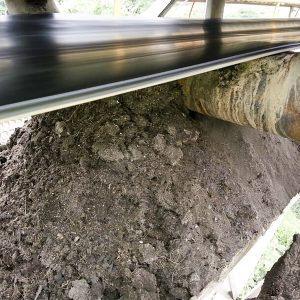Mexican Cement Manufacturer Addresses Conveyor Carryback.
By Mark S. Kuhar
 It took innovative belt cleaning technology to help a Mexican cement manufacturer resolve fugitive material buildup caused by a variety of alternative fuel resources (AFRs).
It took innovative belt cleaning technology to help a Mexican cement manufacturer resolve fugitive material buildup caused by a variety of alternative fuel resources (AFRs).
The second largest cement producer in the country, Holcim Mexico, increased the use of solid and liquid AFRs at one of its facilities, but the change resulted in spillage and carryback that caused equipment failures, cleanup and maintenance costs estimated at $67,000 per month.
The solution from Martin Engineering Mexico, has significantly decreased the amount of spillage, increased workplace safety and lowered the cost of operation.
Located in southeastern Mexico, the Planta Macuspana facility produces 1 million metric tons (1,102,311 tons) of cement annually. Out of Holcim’s total annual output of 12.6 million metric tons (13,889,123 tons) from seven operating plants, nearly 14 percent of the total thermal energy demand was fulfilled by the use of AFRs in 2013.
Using 1990 as a benchmark, the corporation’s entire Mexican cement production has more than doubled, with an increased annual energy consumption of only 45 percent, reducing CO2 emissions per ton of cement by 25 percent. However, maintenance costs threatened to offset the economic benefits of the program.
Several Types of Carryback
Delivered in both solid and liquid forms on seven 40-in.wide (102 cm) conveyor systems, 1.5 metric tons (1.65 tons) of solid waste and 21 metric tons (23 tons) of sludge are carried per hour to the calcinator.
 Solid waste products including paper, wood, plastics and shredded tires are run through a crusher and measured for caloric content (the amount of energy contained within a substance). Consisting of petroleum slurry and contaminated water, the liquid waste is mixed with sawdust and dried before also being measured for caloric content. After processing, the mix is loaded into a feed hopper, passed over a belt scale and distributed by a mechanical feed valve onto the conveyors.
Solid waste products including paper, wood, plastics and shredded tires are run through a crusher and measured for caloric content (the amount of energy contained within a substance). Consisting of petroleum slurry and contaminated water, the liquid waste is mixed with sawdust and dried before also being measured for caloric content. After processing, the mix is loaded into a feed hopper, passed over a belt scale and distributed by a mechanical feed valve onto the conveyors.
Prior to implementing the Martin Engineering components, the Macuspana facility utilized a mix of belt cleaners without tensioners and cleaning systems fabricated in-house, with ineffective results. Spilling approximately 6 tons (5.4 metric tons) of solid and liquid material per month, the process had to be monitored by a full-time employee who reported daily on spillage volume and potential hazards. Twice per month a four-person crew required a full shift of downtime to clean up piles of material and sludge from around the conveyor frame.
Versatile Solutions
Following a thorough assessment of the situation, the Martin Engineering Mexico team determined that a Martin QC1 Cleaner PD (Performance Duty) should be installed at each of the seven conveyor discharge points.
 Integrated onto the existing mainframes, the units are comprised of a single urethane blade connected to a steel mandrel, which is turned by a heavy-duty spring tensioner, retaining a tight seal on the belt. The blade design utilizes patented Constant Angle Radial Pressure (CARP) technology to maintain an efficient cleaning angle throughout its service life, without damage to the belt or splice.
Integrated onto the existing mainframes, the units are comprised of a single urethane blade connected to a steel mandrel, which is turned by a heavy-duty spring tensioner, retaining a tight seal on the belt. The blade design utilizes patented Constant Angle Radial Pressure (CARP) technology to maintain an efficient cleaning angle throughout its service life, without damage to the belt or splice.
For applications involving belt speeds of up to 900 fpm (4.6 m/sec) and service temperatures of -40 to 160 F (-40 to 70 C), operators can choose between five different blade types to address the characteristics of specific kinds of cargo for each conveyor. Available in lengths of 18 to 96 in. (457 to 2438 mm), blades can also be ordered in 10-ft. (3.05 m) slugs, allowing operators to cut to length for increased versatility.
The unit features a no-tool replacement process that can be performed safely by a single worker who simply pulls the locking pin, unclamps the bracket and slides the blade out of the mainframe. The new blade is slipped on and clamped into position, significantly reducing maintenance and replacement time.
Immediate Results
The performance of the system with the newly installed equipment was evaluated over a 28-day period, measuring the buildup of carryback as compared to the month prior to installation. Operators reported approximately 90 percent less fugitive material over the entire evaluation period, resulting in a drastic reduction in labor and downtime needed for cleanup.
Plant managers predict that the upgraded belt cleaning system will extend the life of idlers and other conveyor components, minimizing unscheduled outages due to equipment failures. Moreover, operators confirmed that worker morale was greatly improved due to the easier cleanup and better working conditions.
Information for this article courtesy of Martin Engineering.




